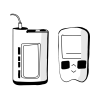Device Combo

Priorities & Concerns
Why did you choose a sensor and pump?
Better control. I started using a pump in 2000. I started using a sensor around 2012. I love love love my sensor and the freedom it has given me to exercise. I also love avoiding low blood sugars at night.
What are the tradeoffs of using a CGM and a pump?
I get tired of the sensor beeping at me at times, especially if my blood sugar is low and I'm waiting for it to climb. But I'm thankful it wakes me up at night!!!
How do you use your data?
I use the data to help me adjust my basal rates for better control.
How do you respond to people when they comment on your devices?
I tell them my story and how these devices have been life changers for me.
How do you make the devices comfortable on your body?
They are not uncomfortable. I keep my pump in my left pocket and sensor in my right pocket.
What helps you trust your devices?
Recalibrating my sensor keeps it more accurate. I have to trust my pump, and I have to be careful about user error.
What would you tell someone considering this same combo?
The sensor can save your life in the event of a low blood sugar. The pump allows me to have more freedom re: food. I'm not locked in to a meal schedule like I was before the pump. I can postpone meals. Also, I don't have to eat a certain number of carbs just because that is what my insulin dose requires.
What challenges do you have and how have you overcome them?
My emergency kit stays packed all the time for travel. I have a backup pump and meter, and I always pack extra insulin and pump supplies. When I travel, my blood sugar always runs low, so I can cut my basal rate back which avoids the severe lows. I know to do a 30% decrease when I travel. Then I readjust things later.
More Wisdom

Even though my pump has malfunctioned before it is worth having because my blood sugar is more in control when I use it.
Ashley


It's worth it to me, particularly when I sleep and wake up to see that the closed loop has gotten my blood sugar down, or suspended my insulin.
Justus


I know that devices are getting better and I want to give myself every opportunity to live as long and healthy as possible.
Michael




